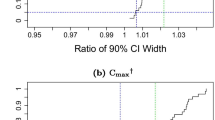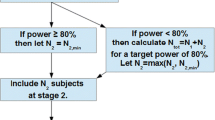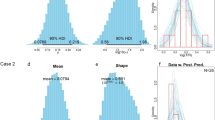Abstract
The statistical test of the hypothesis of no difference between the average bioavailabilities of two drug formulations, usually supplemented by an assessment of what the power of the statistical test would have been if the true averages had been inequivalent, continues to be used in the statistical analysis of bioavailability/bioequivalence studies. In the present article, this Power Approach (which in practice usually consists of testing the hypothesis of no difference at level 0.05 and requiring an estimated power of 0.80) is compared to another statistical approach, the Two One-Sided Tests Procedure, which leads to the same conclusion as the approach proposed by Westlake (2) based on the usual (shortest) 1–2α confidence interval for the true average difference. It is found that for the specific choice of α=0.05 as the nominal level of the one-sided tests, the two one-sided tests procedure has uniformly superior properties to the power approach in most cases. The only cases where the power approach has superior properties when the true averages are equivalent correspond to cases where the chance of concluding equivalence with the power approach when the true averages are notequivalent exceeds 0.05. With appropriate choice of the nominal level of significance of the one-sided tests, the two one-sided tests procedure always has uniformly superior properties to the power approach. The two one-sided tests procedure is compared to the procedure proposed by Hauck and Anderson (1).
Similar content being viewed by others
References
W. W. Hauck and S. Anderson. A new statistical procedure for testing equivalence in two-group comparative bioavailability trials.J. Pharmacokin. Biopharm. 12:83–91 (1984).
W. J. Westlake. Response to T. B. L. Kirkwood: Bioequivalence testing-a need to rethink.Biometrics 37:589–594 (1981).
S. Anderson and W. W. Hauck. A new procedure for testing equivalence in comparative bioavailability and other clinical trials.Comm. Stat. A 12:2663–2692 (1983).
D. M. Rocke. On testing for bioequivalence.Biometrics 40:225–230 (1984). (See also Correspondence inBiometrics 4:561–563 (1985).)
W. J. Westlake. The design and analysis of comparative blood-level trials. In J. Swarbrick (ed.),Current Concepts in the Pharmaceutical Sciences, Dosage Form Design and Bioavailability, Lea and Febiger, Philadelphia, 1973, pp. 149–179.
D. Mandallaz and J. Mau. Comparison of different methods for decision-making in bio-equivalence assessment.Biometrics 37:213–222 (1981).
C. S. Locke. An exact confidence interval from untransformed data for the ratio of two formulation means.J. Pharmacokin. Biopharm. 12:649–655 (1984).
Author information
Authors and Affiliations
Rights and permissions
About this article
Cite this article
Schuirmann, D.J. A comparison of the Two One-Sided Tests Procedure and the Power Approach for assessing the equivalence of average bioavailability. Journal of Pharmacokinetics and Biopharmaceutics 15, 657–680 (1987). https://doi.org/10.1007/BF01068419
Received:
Revised:
Published:
Issue Date:
DOI: https://doi.org/10.1007/BF01068419




